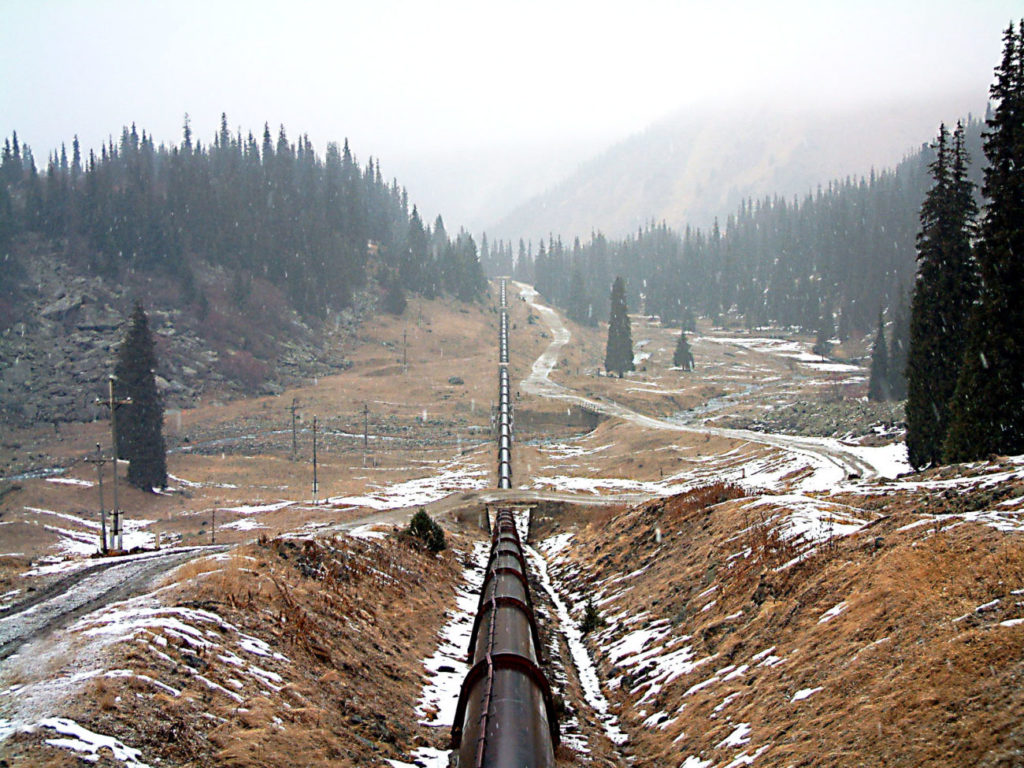DECODING. According to the last report from the intergovernmental panel on climate change (IPCC), Central Asia is one of the rarest regions in the world where both droughts and excessive rainfall in large quantities are observed. The average temperatures of these countries in the region have already crossed the 2 degrees Celsius threshold since 1990.However, there is no time for panic: Central Asia is already used to the harsh climate, where the temperature difference can sometimes differ as much as 80 degrees Celsius over the course of a year. Simultaneously, the researchers of IPCC are faced with a lack of more detailed data regarding Central Asia, which makes modelling difficult. How will the climate in Central Asia change? Novastan tries to make sense of it. This article was originally published on Novastan’s French website on September 13, 2021. In recent years, the extreme climatic events in Central Asia are becoming more and more visible: more frequent heat waves, flooding, low rainfall, etc. The region, like the rest of the world, is not immune to what appears to be an accelerating climate change. On 9 August, the intergovernmental panel on climate change (IPCC) published the first part of their report describing the state of the world’s climate. The nearly 4000 pages report focuses on the known physical change. Central Asia is squeezed between the two paragraphs, as an illustration of its position in today’s information flows.
Extreme Rainfall and Drought
“The vast regions of Central and Eastern Asia have been drying up at the start of the 2000s due to hotter temperatures, lower humidity, declining soil moisture (Wei and Wang, 2013: Li et al., 2017d; Hessl and coll.,2018)’’, described the IPCC scientists. “The Himalayan glaciers supply ten of the most important river systems in the world and are critical water sources for almost two billion people (Wester et al., 2019). However, they are part of the most vulnerable “water towers” (Immerzeel et al., 2020) which are expected to experience volume losses of around 30% to 100% by 2100, according to global emission scenarios (Marzeion et al., 2020). According to the global emission scenarios, the glaciers of this region should reach their maximum run-off between 2020 and 2040 (Marzeion et al., 2020)”, went on the panel. Read more on Novastan: Aralsk: Pictures Of The Vanished Aral Sea On a wider level, Central Asia is one of the few regions in the world which receives both the most extreme rainfall and experiences hot weather episodes, or even droughts, describes the IPCC. According to Alisher Mirzabaev, a researcher on climate change at the University of Bonn, this situation is due to the fact that the region is subject to a large variety of climates. “Most of the cultivated land of Kazakhstan receives rainwater, while other countries irrigate their land mainly with water coming from the glaciers”, explains the Uzbek researcher, contacted by Novastan. This distinction between the origin of water appears essential for the years to come.
A Change of the Origin of Water
“The north of Kazakhstan generally experiences a drought every three to four years. With climate change, this area may experience heavy rains in certain years while in some other years there will be much greater droughts”, wrote Alisher Mirzabaev. “This situation leads to more variability for the grain harvests. In the mountainous regions, especially of Tajikistan and of Kyrgyzstan, strong rainfall episodes will lead to a higher risk of floods leading to a landslide”, explains the Uzbek specialist. Read more on Novastan: Life By The River: The Naryn In Kyrgyzstan“Tajikistan and Uzbekistan are likely to receive more precipitation during winter, but less in summer. It is problematic because there are neither crops in winter, nor irrigation. Water will accumulate in the reservoirs, which are fortunately numerous. However, the mountainous zones are going to face challenges due to more flooding”, estimated the researcher. What is most problematic is the shift in water supply, when the areas used to receive it through the snowmelt get it from the rain instead. This change may explain how Central Asia have both more rain and more drought, since the water received by the rain may not be accumulated in mountainous areas. However, this change does not seem to overly worry Alisher Mirzabaev. “Solutions do exist, particularly [the problem can be solved] by the construction of reservoirs or through better coordination between countries upstream and downstream. There is no need to panic at this stage, these solutions must simply be explored and implemented on a larger scale,’’ estimated the Uzbek researcher.
A Sharp Rise in Temperature
Beyond the water, one of the most evocative points of the report about Central Asia is the changing temperature of the region. “Aridity in eastern and western Central Asia is likely to increase, especially after the second half of the 21st century, with an average 2 degrees rise of temperatures worldwide”, describe the IPCC researchers. It is regularly reported that the temperature in Central Asia has already exceeded the 2°C increase and the region is warming twice as fast as elsewhere in the world.
“These days, when we talk about global temperatures, it is about the surface average between the temperature of the land and the ocean. But the land is getting warmer much faster than the ocean. The temperature on the land is already above 1.5°C in most parts of the world”, says Alisher Mirzabaev. “Due to the continental location of Central Asia, this twice as fast increase is not as dramatic as it would seem”, relativizes the researcher. Alisher Mirzabaev also points out that the region has a very high degree of temperature variability, particularly in certain regions of Kazakhstan where the thermometer can show -40°C in winter and +40°C in summer. “The key issues for Central Asia are extreme weather events such as heatwaves, droughts or sudden snow and spring frost”, estimates Alisher Mirzabaev. In this respect, the increase in temperature variability could be the real danger, says the Uzbek researcher.
A lack of Accurate Data in Central Asia
More broadly, however, accurate data for effective modelling seems to be lacking in Central Asia. Weather data do not make up for nearly 400 weather stations in the region and a dense network when it comes to climate change. “To be more precise, you must have information regarding the evolution of glaciers, sand and dust storms… There are so many parameters. Usually, this type of information is better in Central Asia than the developing countries but is much poorer than the level of developed countries”, described Alisher Mirzabaev. Collected information also seems difficult to access, which may prevent the publication of scientific articles on the topic, which will then be used in IPCC reports. “The modelling skills are missing. We should have more studies bringing global modelling at a local level’’, added the Uzbek researcher. On the specific point of IPCC, Alisher Mirzabaev is the only Central Asian researcher who has directly been involved in writing reports or editing them. Read more on Novastan: Troubled Waters: Turkmenistan’s Environmental Policy This situation could change in the future, with the integration of the Regional Environmental Centre for Central Asia (Carec) as an IPCC Partner in May 2020. This centre based in Almaty, Kazakhstan, is one of the best in the region. For the seventh IPCC report, planned in 2028, Alisher Mirzabaev wants to believe that he will not be the only person to bring a more local point of view. Meanwhile, the second and third part of the IPCC report, on the impact and adaptation of climate change as well as the ways of fighting against climate change should be published by spring 2022. This makes a more and more concrete climate threat, in which human responsibility is unambiguously asserted.
Etienne Combier Editor-in-chief of Novastan
Translated from French by Susan Higgins
Edited by Emma Bekrine
For more news and analysis from Central Asia, follow us on Twitter, Facebook, Telegram, Linkedin or Instagram.
 Climate change could lead to ever more fluctuated temperatures in Central Asia
Climate change could lead to ever more fluctuated temperatures in Central Asia 



